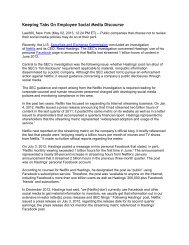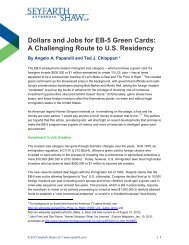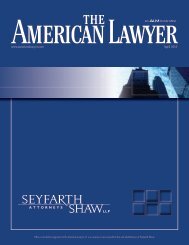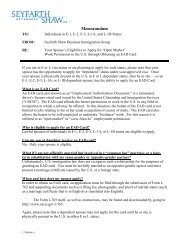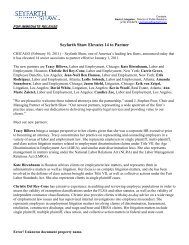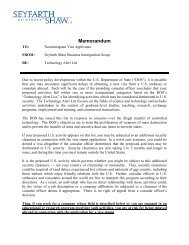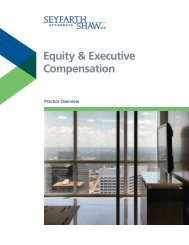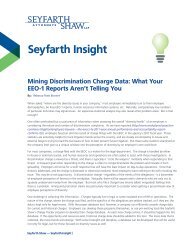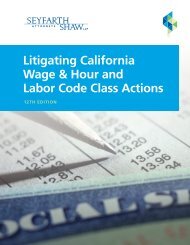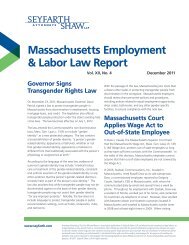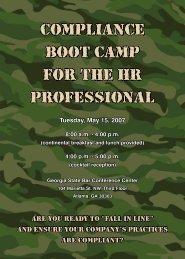ConstructionLawReport 7-06 v.2.qxp - Seyfarth Shaw LLP
ConstructionLawReport 7-06 v.2.qxp - Seyfarth Shaw LLP
ConstructionLawReport 7-06 v.2.qxp - Seyfarth Shaw LLP
You also want an ePaper? Increase the reach of your titles
YUMPU automatically turns print PDFs into web optimized ePapers that Google loves.
Construction Law Report<br />
The requirements for certification are set out in the<br />
Internal Revenue Code, § 45L(c)(1). To be certified:<br />
• The residence must annually use no more than<br />
50% of the amount of energy used by a<br />
comparable unit that meets the 2004<br />
International Energy Conservation Code<br />
Supplement standard; and<br />
• The residence must install heating and cooling<br />
improvements to the building envelope that will<br />
reduce energy consumption to a level that is at<br />
least 10% below that of a comparable envelope.<br />
Credit is also available to manufactured homes<br />
(factory built or prefabricated homes, including mobile<br />
homes) that are built in compliance with the Federal<br />
Manufactured Home Construction and Safety<br />
Standards. The credit is only available to<br />
manufactured homes built after December 31, 2005,<br />
and prior to January 1, 2008. The amount of tax credit<br />
awarded ranges from $1,000 to $2,000, subject to the<br />
level of energy efficiency attained.<br />
In addition, credit for 10% of the cost of installing<br />
energy-efficient building equipment is available for<br />
qualifying components installed within the primary<br />
residence between December 31, 2005, and January<br />
1, 2008. These credits may be combined with other<br />
tax incentives, such as systems, products, or building<br />
credits, to result in a larger award. Energy-efficient<br />
windows, doors, roofs, heating and cooling equipment<br />
are the qualified improvements eligible for a credit of<br />
up to $500 if these items are new and expected to<br />
remain in use for at least five years. The $500 credit<br />
limit is a lifetime credit. Only $200 of that credit may<br />
be used toward the installation of windows.<br />
A 100% tax credit is available for the installation of<br />
“qualified energy property” such as fans (up to $50),<br />
oil or natural gas boilers (up to $150), and central<br />
heating or air-conditioning systems (up to $300). Also,<br />
taxpayers may receive a 30% credit toward the<br />
installation of solar hot water heaters (up to $2,000)<br />
and 30% credit toward the installation of photovoltaic<br />
(solar-electric) systems (up to $2,000).<br />
Taxpayers who implement energy-efficient<br />
improvements to commercial buildings are eligible to<br />
receive EPAct’s tax incentives in the form of tax<br />
deductions. Improvements must be made pursuant to<br />
a plan certified by the IRS before the tax deduction is<br />
taken. Eligible buildings that decrease their annual<br />
use of energy by 50% relative to the American Society<br />
of Heating, Refrigerating, and Air Conditioning<br />
Engineers’ 2001 Standard are eligible for a tax<br />
deduction equivalent to the cost of the installation of<br />
energy-efficient property, up to $1.80/square foot In<br />
addition, building sub-systems may be eligible for a<br />
partial deduction of up to $.60/square foot. These<br />
incentives apply to buildings constructed after<br />
December 31, 2005, and prior to January 1, 2008,<br />
although this date may be extended through 2009 or<br />
2010. If the plan for energy-savings improvements is<br />
not fully implemented, the deduction is subject to<br />
recapture.<br />
CAUTION: In the case of privately owned buildings, the<br />
incentives are generally awarded only to the original owner<br />
or renovator. In the case of publicly owned buildings, the<br />
incentives are normally available only to the entity<br />
responsible for the renovation.<br />
Mark L. Johnson<br />
Any tax information or written tax advice contained<br />
herein is not intended to be and cannot be used by<br />
any taxpayer for the purpose of avoiding tax penalties<br />
that may be imposed on the taxpayer. (The foregoing<br />
legend has been affixed pursuant to U.S. Treasury<br />
Regulations governing tax practice).<br />
<strong>Seyfarth</strong> <strong>Shaw</strong> <strong>LLP</strong> | 6



